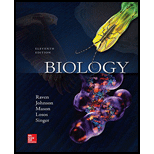
Concept explainers
Humans and pufferfish diverged from a common ancestor about 450 MYA, and these two genomes have
a. very few of the same genes in common.
b. all the same genes.
c. a large proportion of the genes in common.
d. no
Introduction:
Divergent evolution shares common ancestors between two or more species. Such organisms have same structures that are located on different positions in the body as per their need but perform different functions. Such organisms are homologous to each other as they have common homology between them.
Answer to Problem 1U
Correct answer:
Humans and pufferfish diverged from common ancestors about 450 MYA, so they have a large proportion of common genes. Therefore, option c.is correct.
Explanation of Solution
Reason for the correct statement:
Human teeth are evolved from puffer fish, which is later turned into beak in fish. Pufferfish and humans share a common ancestor as they contain a genome known as the fugu genome for over 450 million years ago. This genome is found in fish, but it is also present in humans in the same numbers. However, its size is larger in humans because of the presence of more repetitive DNA in the human genome.
Option c.is given as “a large proportion of gene is common”.
As “pufferfish and humans share common ancestry between them as they have a large proportion of identical genes”, it is the right answer.
Hence, option c.is correct.
Reasons for the incorrect statements:
Option a. is given as “a very few of the same gene in common”.
Pufferfish and human shares common ancestry and human teeth are also evolved from fish. Hence, it is a wrong answer.
Option b.is given as “all the same genes”.
If all the genes are the same between two different species, then there is no such variation that occurs among the individuals among species. Hence, it is a wrong answer.
Option d.is given as “no nucleotide divergence”.
Divergence involves the similarities of amino acids in protein and nucleotide sequence of DNA and RNA between organisms that share a common ancestry. Hence, it is a wrong answer.
Hence, options a., b., and d. are incorrect.
Conclusion:
Human and pufferfish have many identical genes and share common ancestors. However, with time, these genes are rearranged to bring genome revolution, which reveals that the structures might be changed but its function remains the same.
Want to see more full solutions like this?
Chapter 24 Solutions
Biology
- What symbolic and cultural behaviors are evident in the archaeological record and associated with Neandertals and anatomically modern humans in Europe beginning around 35,000 yBP (during the Upper Paleolithic)?arrow_forwardDescribe three cranial and postcranial features of Neanderthals skeletons that are likely adaptation to the cold climates of Upper Pleistocene Europe and explain how they are adaptations to a cold climate.arrow_forwardBiology Questionarrow_forward
- ✓ Details Draw a protein that is embedded in a membrane (a transmembrane protein), label the lipid bilayer and the protein. Identify the areas of the lipid bilayer that are hydrophobic and hydrophilic. Draw a membrane with two transporters: a proton pump transporter that uses ATP to generate a proton gradient, and a second transporter that moves glucose by secondary active transport (cartoon-like is ok). It will be important to show protons moving in the correct direction, and that the transporter that is powered by secondary active transport is logically related to the proton pump.arrow_forwarddrawing chemical structure of ATP. please draw in and label whats asked. Thank you.arrow_forwardOutline the negative feedback loop that allows us to maintain a healthy water concentration in our blood. You may use diagram if you wisharrow_forward
- Give examples of fat soluble and non-fat soluble hormonesarrow_forwardJust click view full document and register so you can see the whole document. how do i access this. following from the previous question; https://www.bartleby.com/questions-and-answers/hi-hi-with-this-unit-assessment-psy4406-tp4-report-assessment-material-case-stydu-ms-alecia-moore.-o/5e09906a-5101-4297-a8f7-49449b0bb5a7. on Google this image comes up and i have signed/ payed for the service and unable to access the full document. are you able to copy and past to this response. please see the screenshot from google page. unfortunality its not allowing me attch the image can you please show me the mathmetic calculation/ workout for the reult sectionarrow_forwardIn tabular form, differentiate between reversible and irreversible cell injury.arrow_forward
 Biology (MindTap Course List)BiologyISBN:9781337392938Author:Eldra Solomon, Charles Martin, Diana W. Martin, Linda R. BergPublisher:Cengage Learning
Biology (MindTap Course List)BiologyISBN:9781337392938Author:Eldra Solomon, Charles Martin, Diana W. Martin, Linda R. BergPublisher:Cengage Learning Concepts of BiologyBiologyISBN:9781938168116Author:Samantha Fowler, Rebecca Roush, James WisePublisher:OpenStax College
Concepts of BiologyBiologyISBN:9781938168116Author:Samantha Fowler, Rebecca Roush, James WisePublisher:OpenStax College Human Heredity: Principles and Issues (MindTap Co...BiologyISBN:9781305251052Author:Michael CummingsPublisher:Cengage Learning
Human Heredity: Principles and Issues (MindTap Co...BiologyISBN:9781305251052Author:Michael CummingsPublisher:Cengage Learning Biology: The Dynamic Science (MindTap Course List)BiologyISBN:9781305389892Author:Peter J. Russell, Paul E. Hertz, Beverly McMillanPublisher:Cengage Learning
Biology: The Dynamic Science (MindTap Course List)BiologyISBN:9781305389892Author:Peter J. Russell, Paul E. Hertz, Beverly McMillanPublisher:Cengage Learning
 Human Biology (MindTap Course List)BiologyISBN:9781305112100Author:Cecie Starr, Beverly McMillanPublisher:Cengage Learning
Human Biology (MindTap Course List)BiologyISBN:9781305112100Author:Cecie Starr, Beverly McMillanPublisher:Cengage Learning





